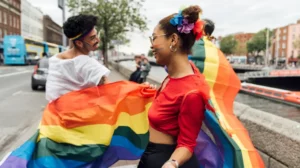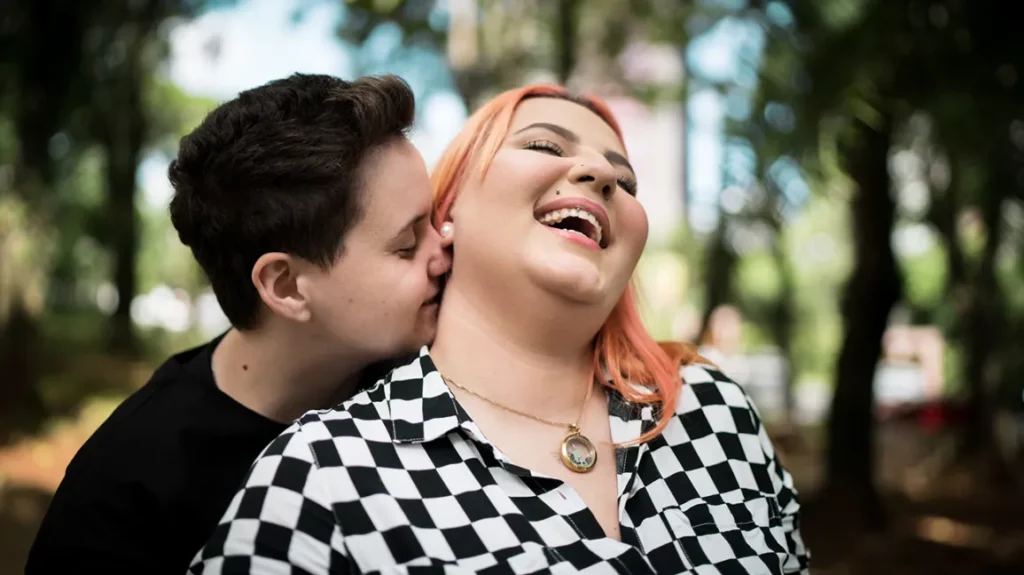Two of these threads – pansexual and bisexual – have gained more recognition in recent years. Yet many people still struggle to understand them fully. In this blog post, we’ll explore these orientations in-depth, shedding light on their definitions, their differences, their common misconceptions, and their unique challenges. We aim to promote understanding and inclusivity, helping to build a world where everyone is celebrated for who they are and who they love.
Contents
What Does Pansexual and Bisexual Mean?
 Pansexuality and bisexuality are two distinct sexual orientations, each with its unique definitions and nuances.
Pansexuality and bisexuality are two distinct sexual orientations, each with its unique definitions and nuances.
Pansexuality: A pansexual person is someone who has the potential for emotional, romantic, or sexual attraction to people regardless of their gender identity. This includes potential attraction to individuals who identify as male, female, transgender, genderqueer, nonbinary, or any other gender.
The term “pansexual” is derived from the Greek prefix “pan,” meaning “all.” Therefore, pansexuality is often understood as the attraction to all genders or the capacity to be attracted to a person irrespective of their gender.
Bisexuality: Bisexuality refers to the potential to be attracted—romantically and/or sexually—to people of more than one gender, not necessarily at the same time, in the same way, or to the same degree. This definition, popularized by bisexual activist Robyn Ochs, suggests that bisexuality includes a wide spectrum of attractions.
It’s important to note that the term doesn’t imply attraction only to two genders (male and female). Despite what the “bi-” prefix might suggest. Instead, it recognizes that there are more than two genders.
Each individual’s experience with their sexual orientation is unique. And labels are merely tools that can help someone understand and communicate their experiences better.
Key Differences Between Pansexual And Bisexual
While both pansexual and bisexual embrace the potential for attraction to more than one gender, there are some key differences that typically distinguish these two orientations:
Perception of Gender
The most commonly highlighted difference between pansexuality and bisexuality revolves around the perception of gender. Pansexuality is often described as “gender-blind”, meaning that a pansexual person’s attraction to others isn’t limited by or focused on the other person’s gender identity. In other words, for pansexual individuals, gender does not play a crucial role in their romantic or sexual attraction to others.
Bisexual individuals, on the other hand, may often recognize and be attracted to the gender of their potential partners. This doesn’t mean they are attracted to only two genders (despite the common misconception); rather, they are attracted to more than one gender and are typically not “gender-blind.”
Fluidity of Attraction
 While it’s not a definitive rule, some people find that their attractions can be more fluid with bisexuality. For example, a bisexual person may feel more attracted to women at one time and more attracted to men or nonbinary individuals at another. With pansexuality, given the “gender-blind” aspect, this type of fluidity may be less common, as the attraction is not typically tied to gender.
While it’s not a definitive rule, some people find that their attractions can be more fluid with bisexuality. For example, a bisexual person may feel more attracted to women at one time and more attracted to men or nonbinary individuals at another. With pansexuality, given the “gender-blind” aspect, this type of fluidity may be less common, as the attraction is not typically tied to gender.
It’s important to remember that there’s a lot of diversity within each orientation, and these descriptions might not apply to everyone who identifies as pansexual or bisexual. These identities can overlap, and some people might even use both labels to describe their experiences.
The key takeaway is that all identities are valid, and the most important thing is that individuals choose the terms that feel right for them.
Any Similarities Between These Two Identities
Absolutely, there are several similarities between pansexual and bisexual. Here are a few key parallels:
Attraction to Multiple Genders
The primary similarity between pansexuality and bisexuality is that both orientations involve the capacity for attraction to more than one gender. This sets them apart from monosexual orientations like heterosexuality (attraction to a different gender) and homosexuality (attraction to the same gender).
Fluidity of Attraction
While the specifics of how this fluidity manifests can differ, many people who identify as either pansexual or bisexual experience some degree of fluidity in their attractions. This fluidity recognizes that attractions can change over time and aren’t necessarily fixed.
Overcoming Societal Misunderstanding
Both identities often face similar challenges, including misconceptions, stereotypes, and erasure. Both pansexual and bisexual individuals frequently need to explain their identities and correct misunderstandings. They can also experience bi-erasure or pan-erasure. That is the tendency for people to overlook or deny their orientations.
Part of the LGBTQ+ Community
Both pansexual and bisexual individuals are integral parts of the larger LGBTQ+ community. They share in the collective history, challenges, and victories of the community. Even as they navigate the unique aspects of their individual identities.
It’s important to note that while there are similarities, the unique aspects of these identities should be respected and acknowledged. Everyone’s experience with their identity is unique. And the labels they choose to identify with are deeply personal.
Unique Challenges and Experiences of Pansexual and Bisexual Individuals
Pansexual and bisexual individuals, like all members of the LGBTQ+ community, face certain unique challenges and experiences. These challenges often arise from societal misconceptions, stereotypes, and prejudices, and may include:
Biphobia and Panphobia
Biphobia refers to prejudice, fear, or hatred directed towards bisexual people. It can come from both the heterosexual community and within the LGBTQ+ community. Panphobia, similarly, is prejudice against pansexual people. Both can result in discrimination, exclusion, and even violence.
Stereotypes and Misunderstandings
Both identities are subject to numerous stereotypes and misconceptions. For instance, people might wrongly assume that bisexuality means an equal attraction to men and women, dismissing the spectrum of attraction that bisexuality actually encompasses. Similarly, pansexuality is sometimes misunderstood as hypersexuality, which is an entirely separate concept.
Coming Out Challenges
Coming out as bisexual or pansexual can present unique challenges. Given the misconceptions around these identities, individuals may need to do a lot of explaining and myth debunking when they come out. They may also face skepticism or dismissal.
Mental Health Struggles
Research has shown that bisexual people, and likely pansexual people as well, face higher rates of mental health issues compared to heterosexual and some other LGBTQ+ identities. This includes higher rates of anxiety, depression, and suicidality, often due to the pressures of stigma, discrimination, and erasure.
Intersectional Challenges
Many pansexual and bisexual individuals also identify with other marginalized groups, such as being a person of color, being transgender, or having a disability. The intersection of multiple marginalized identities can compound discrimination and make life experiences more complex.
The fight for equal rights and acceptance continues for all within the LGBTQ+ community. By understanding these unique challenges, allies and community members can work to create a more inclusive, supportive, and understanding environment for everyone.
Tips For Supporting Pansexual And Bisexual People
 Supporting pansexual and bisexual people is an essential part of fostering a more inclusive and understanding society. Here are a few tips for how you can be an ally and support the pansexual and bisexual people in your life:
Supporting pansexual and bisexual people is an essential part of fostering a more inclusive and understanding society. Here are a few tips for how you can be an ally and support the pansexual and bisexual people in your life:
1. Educate Yourself and Others
One of the most important things you can do is educate yourself about what pansexuality and bisexuality truly mean. Misunderstandings and misconceptions are rampant, so take the time to learn the facts. Don’t rely on stereotypes or assumptions. Share your knowledge with others when you see misunderstandings or hear damaging stereotypes.
2. Respect Identity and Terminology
Respect the terms that people use to describe their own identities. Don’t argue with someone about how they should identify, or tell them that their identity isn’t valid. Remember that everyone has the right to identify in the way that feels most true for them.
3. Listen and Validate Experiences
Be a good listener when pansexual or bisexual individuals choose to share their experiences with you. Validate their feelings and experiences. Don’t dismiss or minimize the struggles they may face due to their sexual orientation.
4. Challenge Biphobia and Panphobia
If you see or hear biphobia or panphobia – whether it comes in the form of harmful jokes, discriminatory behavior, or exclusionary practices – speak up against it. Challenge prejudice and discrimination wherever you encounter it.
5. Encourage Inclusive Spaces
Whether you’re part of a school, a workplace, or any other community, encourage the creation of inclusive spaces. This could mean supporting LGBTQ+ inclusive policies, participating in or organizing inclusive events, or simply fostering an atmosphere of acceptance and understanding.
6. Be There for Coming Out
If someone comes out to you as pansexual or bisexual, thank them for trusting you, show your support, and reassure them that you’re there for them. Coming out can be a difficult process, so being a supportive presence is incredibly important.
Remember, the best way to support pansexual and bisexual individuals is to respect them, affirm their identities, and stand up against discrimination and prejudice. It’s an ongoing process, but every effort contributes to a more inclusive and accepting world.
Conclusion
Bisexual and pansexual identities provide us with valuable perspectives on the diverse spectrum of human sexuality. Each orientation, each experience, tells a unique story, enriching our collective understanding of the many ways love and attraction can manifest.
It’s important to remember that while labels like bisexual and pansexual can be useful for self-expression and finding community. Still, the experiences of individuals within these categories are diverse and multifaceted. Sexuality is deeply personal and can’t be neatly boxed into predefined categories.
Life may sometimes be challenging for bisexuals, but Online Bisexual Counseling can help. Get experienced LGBTQ therapists at PrideMantra: Book a trial LGBTQ therapy session


